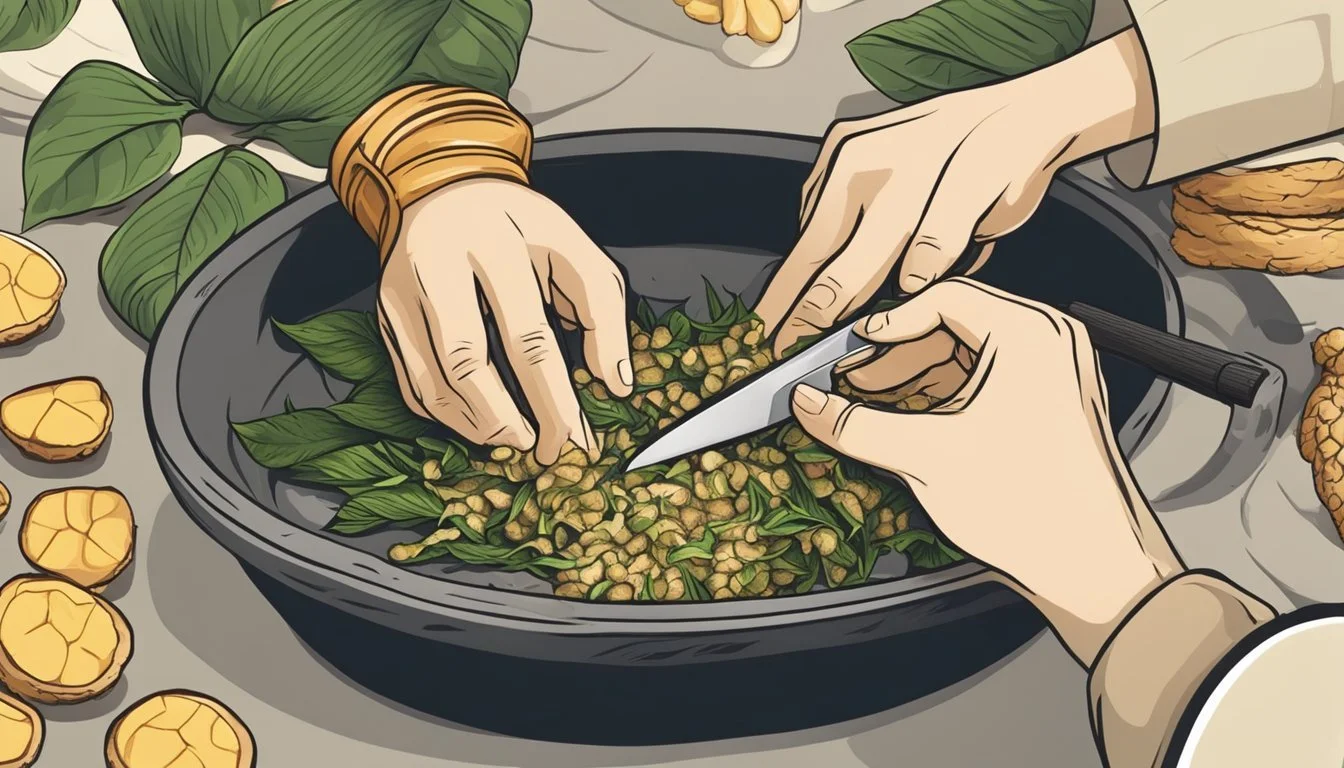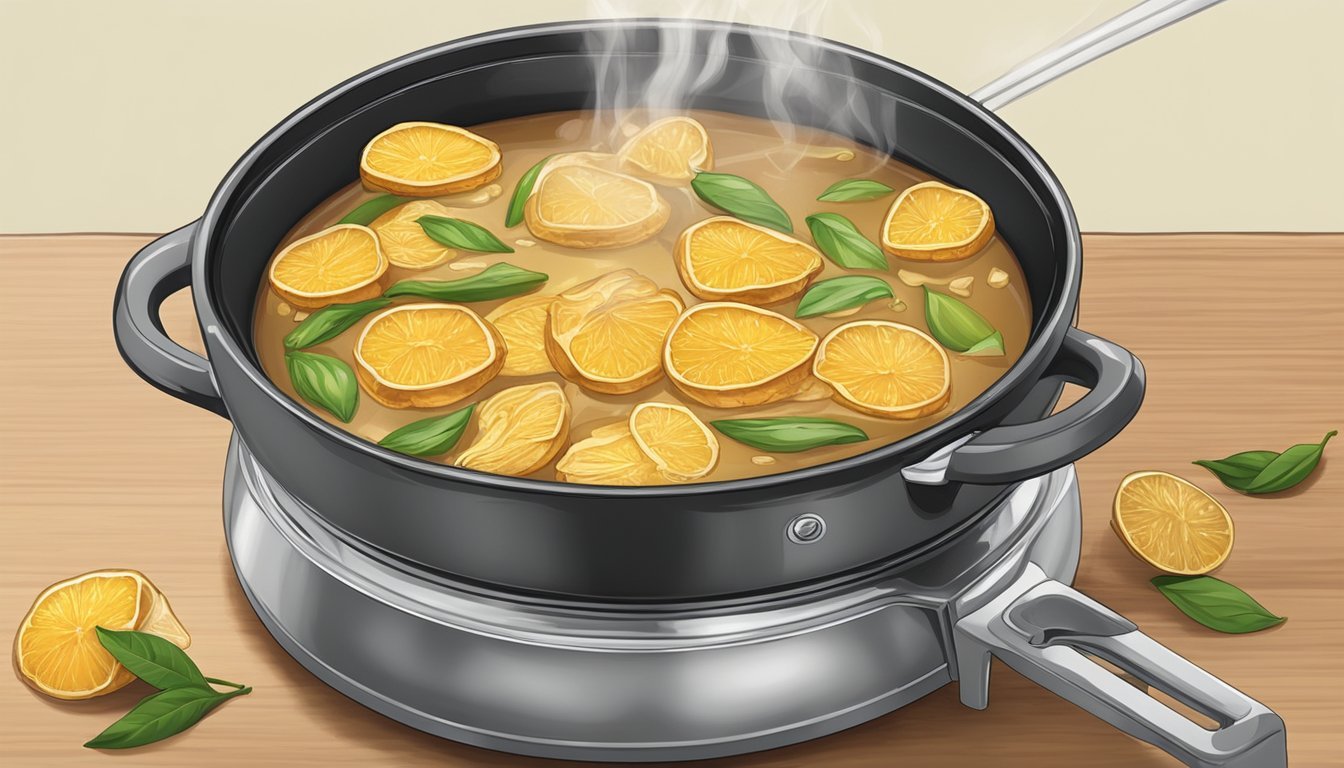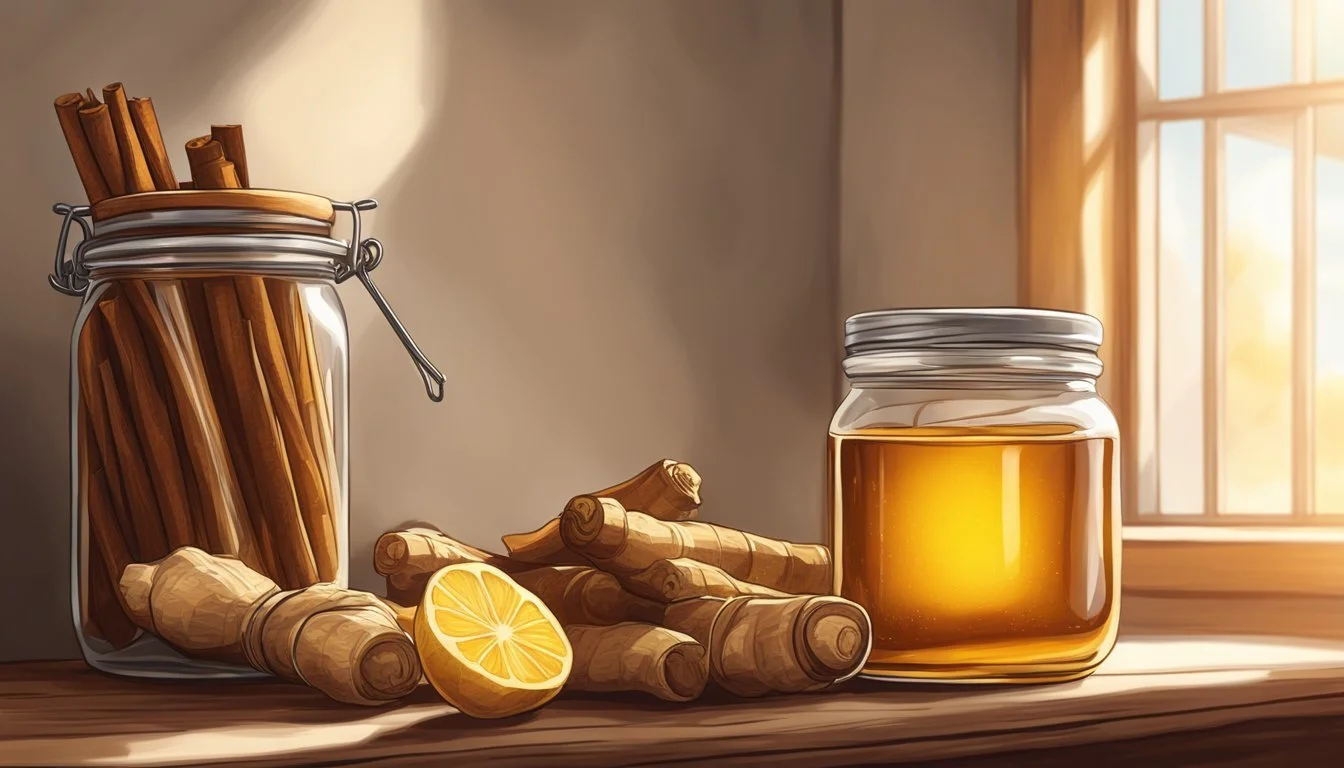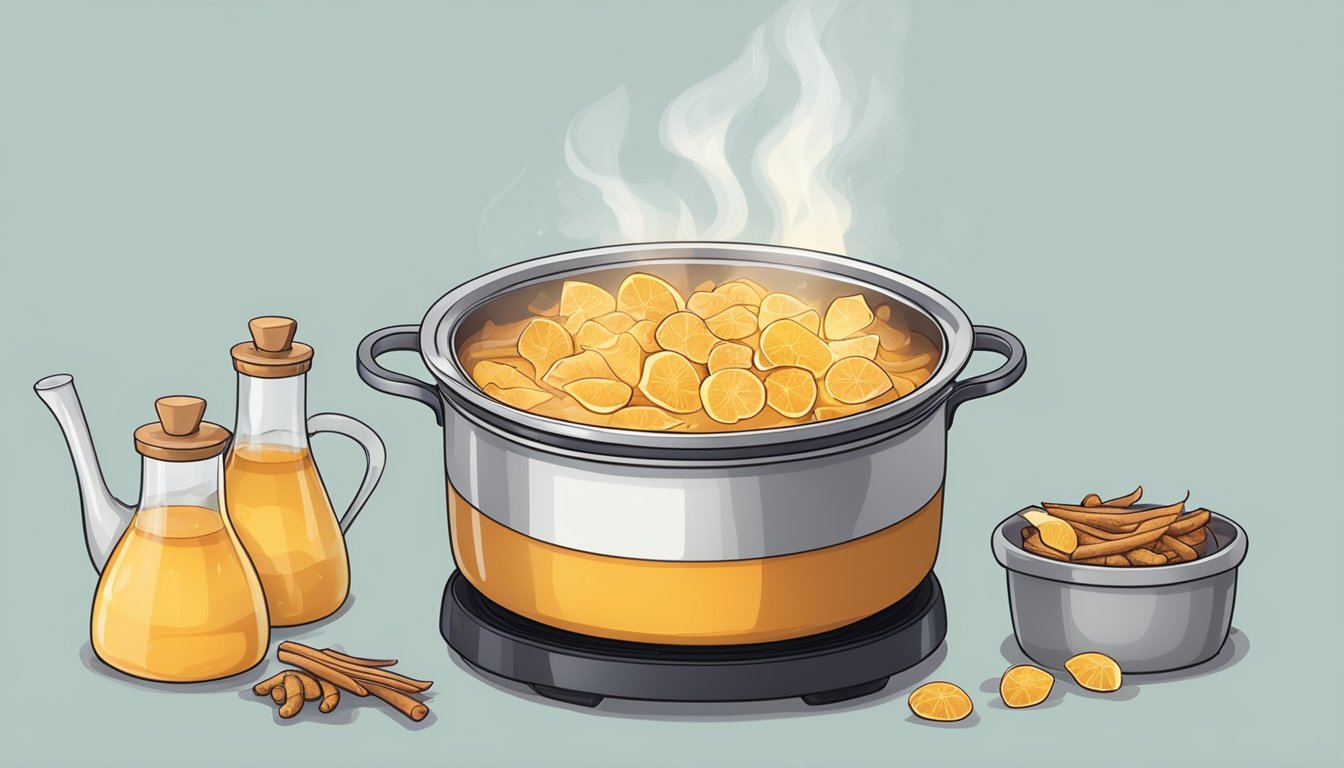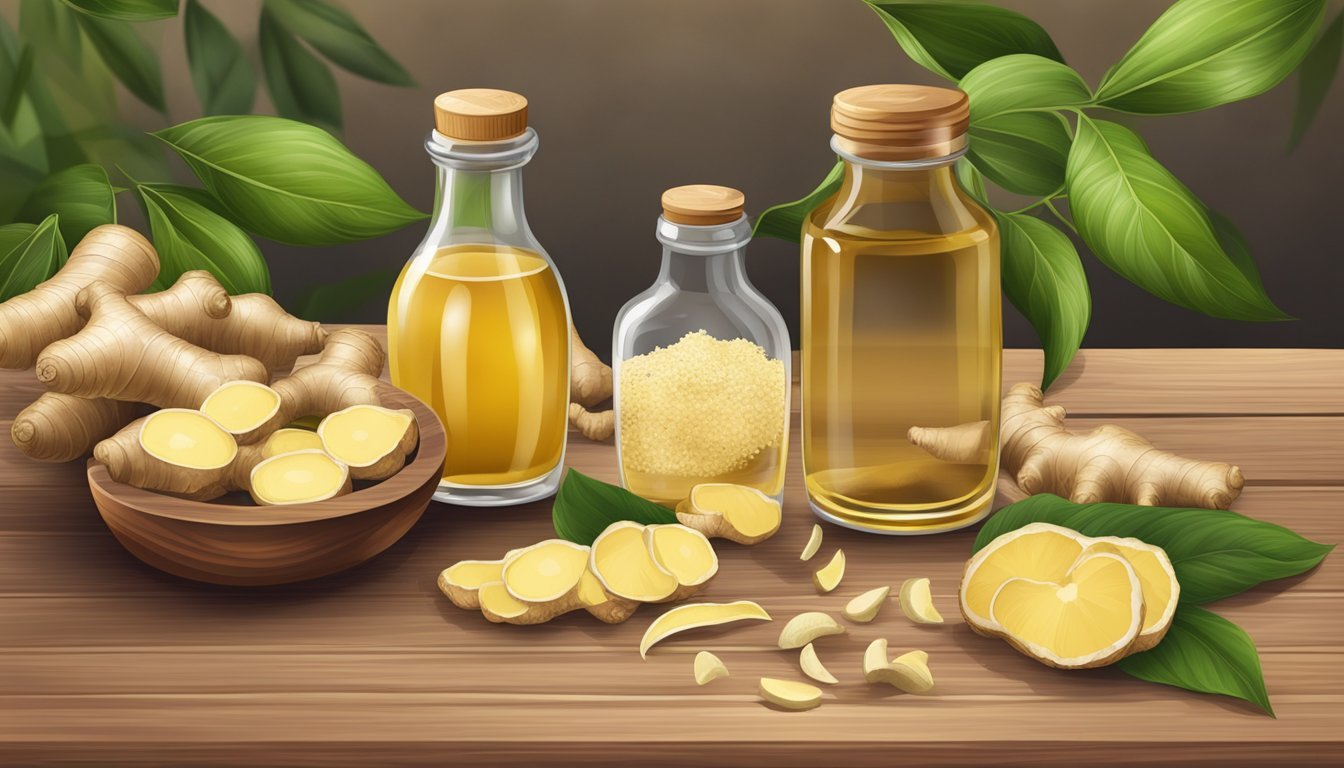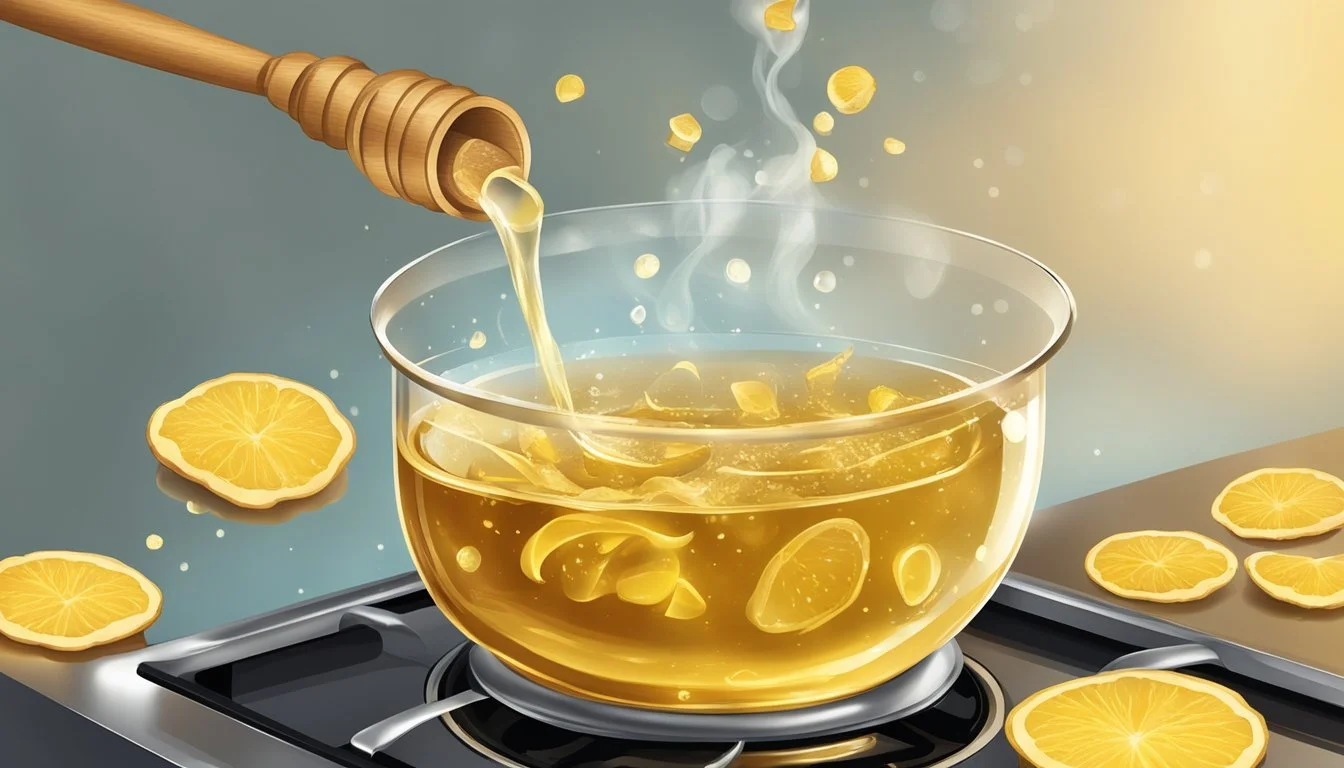Ginger Peel Syrup
A Spicy, Aromatic Sweetener for Culinary Innovation
Ginger peel syrup emerges as a versatile sweetener that harnesses the robust flavors of ginger, creating an aromatic addition to various culinary creations. Its unique spicy kick, paired with its innate sweetness, allows it to stand out among common syrups. Made from the often-discarded peels of ginger, it embodies a sustainable cooking approach that extracts maximum flavor from all parts of the revered spice.
The process of making simple syrup, a solution of sugar dissolved in water, becomes a canvas for infusing the zest of ginger peel. The resulting syrup is not only a sweetener but also a concentrated essence of ginger's distinctive warmth. Chefs and mixologists alike value the depth it adds to dishes and drinks, ensuring that ginger peel syrup is steadily gaining popularity in kitchens and bars around the world.
This syrup can be employed in a myriad of ways, from enhancing cocktails to drizzling over desserts, or even as an ingredient in savory sauce preparations. Its appeal lies in the balanced nature of spicy and sweet, providing a multifaceted taste that complements a wide array of flavors.
The Basics of Ginger Syrup
Ginger syrup is a versatile sweetener that infuses the pungent, spicy flavors of ginger root into a simple syrup base, typically composed of water and sugar. This concoction bridges the gap between culinary traditions and modern-day mixology.
History and Cultural Significance
Ginger syrup has roots in both ancient medicine and traditional cooking, serving as a healing elixir in different cultures while doubling as a core ingredient in various regional recipes. Its warming properties and distinctive taste have been cherished globally, with notable popularity in Asian, Caribbean, and Western cuisines.
Ginger 101
The star ingredient, fresh ginger root, is a rhizome known for its robust, spicy flavor and aromatic qualities. When selecting ginger, one should look for pieces that are firm to the touch and free of blemishes. The peel of ginger, often overlooked, adds an extra zest when included in the syrup-making process.
Ingredients Overview
Ingredients Description Water Serves as the solvent for the syrup, extracting the ginger flavors. Granulated Sugar Acts as the sweetener; dissolves in water to create a simple syrup. Fresh Ginger Contributes the signature spice and aroma; can be used with the peel intact.
Preparation involves simmering these simple ingredients together, allowing the essence of the ginger to seep into the syrup. It is important to avoid boiling the mixture vigorously to preserve the delicate flavors. The final product should be strained to achieve a clear consistency, suitable for use in numerous culinary applications.
Preparation Techniques
Creating ginger peel syrup involves a few critical steps that impart its unique flavor and consistency. Careful peeling, precise simmering, and proper straining are essential to achieve the ideal aromatic sweetener.
Syrup Making Principles
For crafting ginger peel syrup, one starts by selecting fresh ginger and adhering to basic syrup principles. It's imperative to maintain a balance between the sugar and water—commonly at a 1:1 ratio. A saucepan that evenly distributes heat is crucial for a consistent syrup.
Equipment needed:
Medium saucepan
Strainer or cheesecloth
Stirring utensil
Airtight container
Peeling and Slicing Ginger
Peeling ginger requires a gentle hand to avoid wastage. Utilize a spoon or a peeler to remove the skin. Once peeled, the ginger should be thinly sliced or grated. This maximizes the surface area, allowing for better infusion of its spicy notes into the syrup.
Simmering Process
Place the ginger peels into the saucepan, adding equal parts sugar and water. Over medium heat, dissolve the sugar while stirring gently. Once dissolved, reduce the heat to a simmer. A simmer should look like small bubbles occasionally rising to the surface, not a vigorous boil.
Straining the Syrup
After simmering, the infusion needs to cool down. Then, one should strain the syrup to remove the ginger pieces. A fine mesh strainer or cheesecloth ensures that only the liquid remains, resulting in a clear, smooth syrup. Transfer the strained syrup into an airtight container for storage.
Flavor Profile and Variations
Ginger peel syrup captivates with its robust spicy character balanced by natural sweetness. The flavor is both invigorating and warm, serving as a versatile ingredient in various culinary applications.
Sweetness and Spiciness
The spicy heat of ginger stems from gingerol, a compound which is pronounced in the skin of ginger. In syrup form, this spiciness is mellowed by the introduction of sweeteners. This dichotomy is what gives ginger peel syrup its unique appeal. The syrup can be used to enhance beverages like soda or tea with a spicy kick, or to add a layer of complexity to sweet desserts.
Infusion Variants
To adjust the flavor profile of ginger peel syrup, one can infuse additional spices during the preparation. Common additions include:
Cinnamon: Adds a warm, woody note.
Lemon peel: Contributes a citrusy brightness.
Other spices: Cloves, nutmeg, or cardamom can be introduced for more complexity.
The duration and temperature of the infusion process significantly influence the potency of these flavors. A longer steeping time at a lower heat will often result in a more pronounced infusion.
Natural Sweeteners Mix
While the classic ginger simple syrup uses refined sugar, alternative sweeteners offer unique flavor dimensions and varying degrees of sweetness:
Honey: Introduces a floral note; less sweet than sugar.
Maple syrup: Adds a rich, caramel-like sweetness; often more subtle than sugar.
Mixing different natural sweeteners can tailor the final product's sweetness level and flavor profile to the desired outcome. Honey, for instance, pairs exquisitely with lemon to create a ginger syrup variant perfect for cold remedies or as a cocktail base.
Recipes and Applications
Ginger syrup, with its spicy and aromatic profile, enhances a variety of beverages and dishes. It serves as a versatile sweetener that infuses a bold ginger essence into any culinary creation.
Ginger Syrup in Cocktails
Ginger syrup is a staple in the cocktail world for its ability to introduce a warm and spicy layer of flavor. Bartenders often use it to craft a Ginger Martini, where its sweetness complements the herbal notes of the spirits. Another popular concoction is the Ginger Ale Highball, where the ginger syrup intensifies the drink's trademark zing. For a homemade ginger beer, a combination of ginger syrup, soda water, and a twist of lime offers a refreshing and effervescent beverage.
Cocktail Recipe Example:
Ginger Martini:
2 oz Vodka
1/2 oz Dry Vermouth
3/4 oz Ginger Syrup
Ice
Lemon twist for garnish
Mix the vodka, vermouth, and ginger syrup with ice in a shaker. Strain into a chilled martini glass and garnish with a lemon twist.
Tea and Coffee Companions
Ginger syrup can be a delightful companion to both tea and coffee. For a comforting twist on tea, Ginger Tea with a spoonful of ginger syrup can soothe and warm during cooler months, while an Iced Tea sweetened with ginger syrup becomes an invigorating summer refreshment. In the realm of coffee, a dash of ginger syrup lends a subtle spiciness that complements the deep, roasted flavors of coffee beans—especially prominent in beverages like a Gingerbread Latte.
Tea & Coffee Add-in Ideas:
Hot ginger tea
Iced tea with a splash of ginger syrup
Ginger syrup-infused latte
Culinary Uses
In the kitchen, ginger syrup is not limited to beverages; it’s also a fantastic ingredient to sweeten cakes and other baked goods, adding a hint of ginger that pairs exceptionally well with varieties of spices like cinnamon or nutmeg. Drizzling ginger syrup over fresh fruit or lemonade offers a sweet and spicy kick that uplifts these simple, yet classic dishes. For a homemade dessert sauce, ginger syrup can be reduced to a thicker consistency and poured over vanilla ice cream for a unique twist.
Culinary Recipe Suggestions:
Ginger syrup glaze for cakes
Spicy-sweet fruit salad dressing
Reduced ginger syrup dessert sauce
By integrating ginger syrup into cocktails, tea, coffee, and a range of culinary delights, one can elevate the flavors and create exceptional taste experiences with this homemade sweetener.
Storage and Preservation
Ginger peel syrup is a flavorful sweetener that requires careful storage to maintain its quality and extend its shelf life. Proper storage methods will ensure that the syrup retains its spicy and aromatic characteristics.
Proper Storage Methods
For optimal preservation, ginger peel syrup should be stored in an airtight container. Glass jars with tight-fitting lids are ideal as they don't absorb flavors and prevent air from entering. It's important to store the syrup in a cool, dark place, such as a pantry. If one chooses to refrigerate the syrup, placing the jar towards the back of the refrigerator can help in maintaining a consistent temperature.
Shelf Life Insights
At room temperature, ginger peel syrup can last for up to two months when properly stored in an airtight container. If refrigerated, the shelf life extends to about six months. One should always check for signs of spoilage, such as mold or off odors, before use.
Freezing Techniques
For long-term storage, ginger peel syrup can be frozen. Pouring the syrup into an ice cube tray and freezing it allows for easy portioning. Once frozen, transfer the cubes into a freezer bag and keep in the freezer. This method can preserve the syrup for up to a year. To use, simply turn off the heat when preparing a dish or beverage and stir in the ginger syrup cube until melted.
Health Considerations and Nutritional Information
When preparing ginger peel syrup, it is important to be aware of both its nutritional content and its health benefits. While it serves as a flavorful sweetener, one should consider its caloric impact, potential health benefits due to bioactive compounds, and dietary implications.
Caloric and Sugar Content
Ginger peel syrup is essentially a sweetened liquid, with its caloric value primarily derived from sugars. As it is a concentrated substance, the caloric density is high. Typically, a tablespoon of ginger peel syrup may contain:
Calories: Approximately 60
Carbohydrates: 15g
Sugars: 15g
Adding lemon to the syrup can enhance flavor without significantly altering these values.
Health Benefits of Ginger
Ginger, the root from which the peel is derived, contains a compound known as gingerol. Gingerol is associated with various health benefits, including:
Anti-inflammatory effects: May reduce inflammation and related pain.
Digestive aid: Contributes to the promotion of gastrointestinal motility.
Nausea relief: Often recommended for motion sickness and morning sickness.
The peel itself is a source of:
Dietary fiber
Polyphenols: Some research suggests that ginger peel has double the polyphenol content compared to its flesh.
Dietary Considerations
While ginger and its peel contain beneficial nutrients and bioactive compounds, moderation is essential. Users should consider:
Sugar Content: High sugar concentrations make ginger peel syrup unsuitable for unrestricted use, especially for individuals managing blood sugar levels.
Fiber: Minor contributor to daily intake when used in typical quantities.
Fat: Negligible amounts; no significant impact on saturated, polyunsaturated, or monounsaturated fat intake.
Sodium: Minimal contribution to daily sodium intake.
Protein: Not a significant source.
Potassium, Vitamin C, Calcium, Iron: Presence in the syrup is minimal and does not contribute substantially to daily requirements.
Making ginger peel syrup a part of a balanced diet calls for attention to the overall intake of calories and sugars, considering the sweetener as part of the day's total nutrient profile.
Serving Suggestions and Tips
Ginger peel syrup stands as a versatile condiment, adding a spicy kick and aromatic flair to a variety of dishes and drinks. Its concentrated flavor pairs well with both sweet and savory applications, elevating the taste profile of each creation.
Mixing with Beverages
For a refreshing twist to beverages, ginger peel syrup can be diluted with sparkling water to create a homemade ginger ale or added to mocktails for a spicy note. Experimenting with serving sizes, generally starting with one tablespoon per drink, allows for personal preference adjustments. The syrup serves as an excellent base for a classic Moscow Mule, enhancing the cocktail with a bold ginger flavor when combined with vodka and lime.
Enhancing Desserts and Baked Goods
Incorporating ginger peel syrup into desserts and baked goods such as pancakes and waffles imparts a zesty sweetness. Drizzling it over a fruit salad can introduce a unique depth of flavor. To ensure consistent results, utilize a recipe card to record the precise quantities used for future reference.
Creative Uses in Cooking
Ginger peel syrup isn't limited to desserts—it's also a valuable ingredient for creative culinary uses. Its concentrated sugar content and strong ginger flavor make it a unique syrup to glaze meats or to caramelize roasted vegetables. The addition of mint or lime can offer a fresh contrast to the syrup's heat in various sauces and marinades, while a splash in teas can provide a sweet, warming flavor.
Crafting Homemade Syrups
Creating homemade ginger syrup involves a simple process that allows for a wide range of customization, from the type of ginger used to the desired concentration of the syrup. By following specific techniques and instructions, one can prepare delicious syrups even without special kitchen tools.
Ginger Syrup Variants
There are multiple variants of homemade ginger syrup, each with a unique flavor profile. One can choose to peel the ginger for a cleaner taste or keep the skin on for a stronger, spicier kick. The addition of spices such as cinnamon or cloves can create a layered flavor experience. Here are two popular variants:
Simple Ginger Syrup: Combines sugar, water, and fresh ginger, often used for beverages or to sweeten desserts.
Spiced Ginger Syrup: Enhances the basic recipe with spices to complement fall and winter dishes.
Syrup Concentration Techniques
The concentration of ginger syrup is dictated by the ratio of sugar to water and the simmering time. A 1:1 sugar to water ratio yields a typical simple syrup, while a 2:1 ratio leads to a thicker, richer syrup often referred to as a rich simple syrup. Key steps include:
Bringing the mixture to a light simmer to ensure sugar dissolves.
Allowing the syrup to simmer longer if a more concentrated flavor is desired.
Making Syrups without Special Equipment
One can craft homemade syrup without the need for any specialized equipment. A common saucepan, spoon, and strainer suffice for the process. Here are the essential steps:
Combine sugar and water in a saucepan over medium heat.
Stir constantly until the sugar is dissolved fully.
Add ginger slices or pieces and simmer according to the desired concentration.
Cool the mixture before straining to remove ginger pieces.
Store the syrup in an airtight container for future use.
Following these subsections with their respective tips and methods, enthusiasts can easily prepare homemade ginger syrup in their own kitchens.
Frequently Asked Questions
In this section, readers will gain crucial insights into the ingredients, preparation, and storage of ginger peel syrup, enabling them to create this flavorful sweetener with ease and confidence.
FAQs About Ingredients
Q: What parts of the ginger are used to make ginger peel syrup? A: The peelings from fresh ginger root are the main component for making ginger peel syrup, although some recipes may include additional cuts of the ginger for intensified flavor.
Q: Can one use anything besides water and sugar to make this syrup? A: Water and sugar are essential for creating the syrup base, but one can infuse the syrup with ingredients like club soda for a fizzy variation.
FAQs About Preparation
Q: What is the proper way to prepare ginger for syrup? A: The ginger should be scrubbed clean and the peel should be removed if desired. The peeled ginger can then be thinly sliced or chopped to maximize the flavor extraction during simmering.
Q: How is the ginger peel syrup strained? A: One should strain the syrup through a fine-mesh strainer to remove all pieces of ginger peel and any other solids, ensuring a smooth final product.
FAQs About Storage
Q: What is the recommended storage method for ginger peel syrup? A: It is advisable to store ginger peel syrup in an airtight container in the refrigerator to maintain its freshness and prolong its shelf life.
Q: How long does ginger peel syrup last when stored correctly? A: When stored properly in an airtight container in the fridge, ginger peel syrup can typically last for up to a month.
Conclusion
Ginger peel syrup, crafted from the often-discarded skins of ginger, epitomizes resourcefulness in the kitchen. Resourceful and flavorful, this syrup provides a spicy, aromatic sweetener, turning what would be waste into a valuable culinary ingredient.
By simmering ginger peels in a sugar solution, the resulting syrup inherits the zesty essence of ginger, infusing a warm and peppery flavor to beverages and desserts. The syrup's versatility extends beyond sweet applications, as it can be an innovative complement to savory dishes.
Known Benefits of Ginger Peel Syrup:
Sustainability: Utilizes peels that would otherwise be discarded.
Flavor: Adds a complex, spicy note to a variety of recipes.
Versatility: Enhances both sweet and savory dishes.
In a kitchen where creativity merges with ecological mindfulness, ginger peel syrup stands out as a prime example of sustainable practices. It encourages culinary enthusiasts to look at ingredients from a multi-faceted perspective, promoting a waste-less approach that benefits both the palate and the planet.
Individuals who incorporate ginger peel syrup into their food repertoire not only add a unique flavor profile to their creations but also embody a more sustainable and conscientious cooking philosophy. It's a testament to the culinary potential that lies within ingredients often overlooked, solidifying its place as a staple for inventive cooks.



